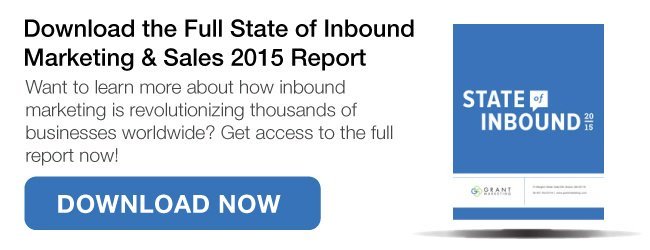Gaining Qualified Leads and Increasing Overall ROI
Leads. We all want them. We need them. We know how crucial generating leads is to your company’s success—and that generating qualified leads shares top spot with closing sales once you nurture them down the funnel. Your boss knows this as well. In fact, CEOs will often put costs in the rearview when generating leads in order to yield successful results. HubSpot’s recently released “State of Inbound 2015” study delves deeper into this trend.

According to the study, which surveyed more than 4,000 marketers around the world, reducing the cost of acquiring leads and customers is 3x less likely to be a top priority of a company as increasing the number of leads and customers is. This trend holds true over all types of company sizes, hinting at the idea that CEOs are not as concerned about the cost of marketing as was once thought. Instead, this statistic shows that CEOs are willing to spend plenty of money to get their needed, most desired lead generation.
ROI Reasoning
Why is this trend proving true across companies, big and small? Perhaps it can be linked to another result from this particular study. Proving the ROI of marketing activities is a higher priority of companies than reducing the cost of lead and customer acquisition is. Do you know what your marketing ROI is? With many businesses turning to inbound marketing and marketing automation, inbound marketing ROI is becoming more traceable. It is now easier for companies to track and measure their success. Due to these marketing advances, CEOs may be more likely to put large amounts of money towards lead generation efforts.
Turing the Trend Around
In reality, it doesn’t have to be this way. Companies should be able to generate their desired number of leads in a costly manner. By doing so, they ensure that they are competitive and profitable at the same time. According to a Salesforce article, there are 5 simple steps your company can take to reduce the cost per lead. We’ve taken the liberty to expand the discussion below.
5 Simple Steps
- Study your sales funnel: Understanding where consumers are in the sales funnel will help your company generate more leads. Marketers will be able to create better-suited marketing strategies to target leads depending on the stage they are at in the funnel. We talk about the sales funnel, but the reality is that it looks, acts, and responds much less like a funnel these days and more like a multi-faceted, multi-tiered touchpoint carousel. Paying attention to prospect and customer habits is key here, because once you have their interest, the stats bear out that your opportunity for converting them grows. The Content Marketing Association (CMA) reports that 82% of people like reading content from brands when it is relevant, and 68% are more likely to spend time reading from a brand they are interested in. B2B-specific stats indicate that 74% of consumers report that positive action is taken as a result of reading content marketing. As well, Content Marketing Institute tells us that 80% of business decision makers prefer to get company information in a series of articles versus an advertisement. So yes, listen, and give the people what they need when they need it, which—as buying patterns show—is 24/7/365. Ensure that your website is working for you when you aren’t. A cohesive content marketing plan is your best sales enablement tool.
- Commit to content marketing: Content Marketing generates 3x as many leads as traditional outbound marketing, but costs 62% less. This stat alone exemplifies how crucial inbound marketing is to lead generation. Content marketing is a simple and effective way to see results, and can be achieved through tasks such as blogging, creating videos, eBooks, white papers, case studies, and infographics, and updating social media. In a 2014 study by Content Marketing Institute, 93% of B2Bs reported using content marketing, however, only 44% have a documented content strategy. Showing ROI on your efforts is tough if you are not documenting your efforts in the first place. Using bits and pieces of a content marketing strategy is ineffective. It’s also vital to be sending relevant data across all channels (and using all channels of inbound methodology). Oracle states it well: “With marketing teams’ fragmented approach to data, content, social and cross-channel engagement, it is no surprise that this broken experience is passed onto our customers. About 78% of customers don’t receive a consistent experience across channels and up to 94% of customers have discontinued communication with a company due to irrelevant messaging.” Wow. This means you have to create a content marketing strategy, commit to it, and execute a congruent experience for prospects and customers before, during, and after the sale. Because part of ROI is to keep them coming back.
- Embrace marketing automation: A large number of B2B companies are using marketing automation to generate leads through lead nurturing. According to HubSpot, businesses using marketing automation see a 451% increase in qualified leads. Many still consider marketing automation (generally triggered by “outbound” emails) one piece of an overall inbound marketing strategy. The thought is that people receive the emails and then circle back to you via content you provide them. The automation part is what really makes this tick. Once set up in a marketing/sales software platform, that initial email can trigger a host of responses and prompts to prospects and customers that keeps them interested through sending targeted content to them based on what they have or have not clicked on previously. There is some investment in time up front to set this in place, but once this ball is rolling, you save immense chunks of time and resources letting the automated software do the work for you. It cannot be understated how effective this is for the prospect/customer experience. Prompts based on the interests they have demonstrated help keep them nurtured and engaged—keeping them interested and in the funnel. It’s a massively efficient use of everyone’s time. Here are a couple more stats, in case you need more persuading. Companies that automate their lead nurturing cycle see a 10+% increase in revenue with 6 to 9 months (Gartner), and 44% of brands that use marketing automation software see RIO within 6 months, while 75% see ROI after one year (Groove Digital Marketing). It’s time to start automating and using your time (and money) more effectively.
- As if this isn’t enough, here’s some cost-saving info taken from a HubSpot blog:
- Companies that excel at lead nurturing generate 50% more sales-ready leads at 33% lower cost. (Forrester Research)
- Nurtured leads make 47% larger purchases than non-nurtured leads. (The Annuitas Group)
- Companies with mature lead generation and managements practices have a 9.3% higher sales quote achievement rate. (CSO Insights)
- Relevant emails drive 18x more revenue than broadcast emails. (Jupiter Research)
- Gartner estimates a 15% savings on creative productions with marketing automations and a 5% reduction in marketing waste through automating fulfillment.
- Event-triggered marketing can potentially save 80% of your direct mail budget. (Gartner Research)
- As if this isn’t enough, here’s some cost-saving info taken from a HubSpot blog:
- Optimize organic speech: Consumers are constantly conducting research online before purchasing a service or product. While pay-per-click campaigns may increase immediate traffic, the best way to go about generating consistent, qualified leads is through organic content. Today’s consumers are better educated and self-educated. On average, B2B customers conduct 12 searches before checking a specific brand’s website (Kapost), and go through almost 60% of the buying cycle before talking to sales (Executive Board). Convert with Content reminds us that “lots of searchers have trained themselves to even ignore ‘paid results’ completely” when in search of relevant content. The assumption is that people want content from a supplier of products and services that they trust—and they want to discover that on their own terms. This generally means that the leads that do come to you via content channels are self-qualifying to a large degree and come to you with built in trust for your brand. And while there is a cost associated with setting up viable, consistent inbound content channels, many of them are “evergreen” in nature and over time, their ROI increases both in mitigated set-up costs (one-time, initial production already accounted for) and ROI numbers as noted above. In terms of your ROI on paid search specifically, a blog by Impact cites Eloqua with this stat: mid-sized businesses save 31% on inbound marketing costs compared to paid search. Strong search engine optimization strategies will provide consistent organic search results and can garner you qualified leads. Building good search engine results page (SERP) status can take time. Once established—and maintained well—your organic value can continue to grow and reap many solid, qualified leads.

- Step up your social media marketing: Social media is a very cost effective and easy way to connect with potential leads and valued customers. Sites like Twitter, Facebook, and LinkedIn allow your business to reach your target market (and then some) quickly and effectively. Case in point, many of the online articles I referred to while writing this had “pre-set” retweets ready to go. All I had to do was click on them and retweet little sound bites of info—for these other media outlets and businesses. Can’t get much easier than that! We’ve had great success with our clients at Grant Marketing by using LinkedIn’s “sponsored updates.” You can choose the companies you want to target your focused content on, and while it is a paid program, the pricing is based on impressions or clicks and you can set a very modest budget for widespread exposure. Tracking ROI from social media requires that you first establish what your goals from your social media outlets will be. Ultimately, we all want conversions to leads to translate into sales. Keep in mind, given today’s purchasing patterns, we are working from a model that uniquely nurtures prospects and customers through and around the sales cycle. So, your marketing media touchpoints include shares and likes, newsletter sign-ups, PDF downloads, social interactions, video views, lead-converting contact forms, and online purchases, among other desired actions. You need to know where your audience is and what platform they are using and engaged with. LinkedIn is, by far, the platform of choice for B2B interests. Interestingly, HubSpot reports that 71% of marketers are using social media to gain marketplace intelligence. That’s an unexpected and peripheral benefit of effectively using social media. If you are not on a marketing/sales software platform, you are missing out on valuable ROI tracking info that a good software platform can collect and report on for you. What are some of those stats, according to HubSpot?
- By spending as little as 6 hours per week, over 66% of marketers see lead generation benefits with social media.
- Nearly half of those who spend at least six hours per week on social media efforts saw a benefit of reduced marketing expenses.
- More than 58% of marketers who have been using social media for one year or longer improved search engine rankings.
Maybe your CEO has issued the decree to get more leads regardless of the cost. We don’t hear that too often with mid-sized companies, though. And while reducing cost of acquiring leads may not be a top priority of every company, any steps that can decrease the costs of business will help demonstrate positive ROI across the board.
This is one deep-dive discussion that the insightful info included in the State of Inbound 2015 has sparked for us. Click here to read more and download it now.
Many thanks to freelance writer, Samantha Hunter, for her contributions to this blog.


